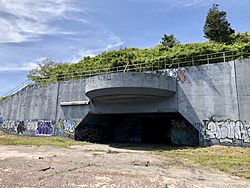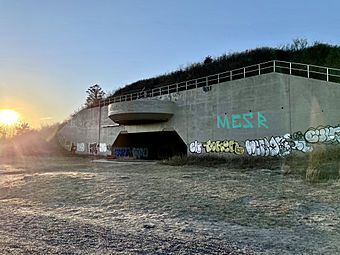Fort Tilden facts for kids
Quick facts for kids Fort Tilden |
|
|---|---|
| Part of Harbor Defenses of Southern New York | |
| Queens, New York | |

View of the abandoned fort in June 2020
|
|
| Type |
|
| Site information | |
| Controlled by | U.S. Army |
| Site history | |
| Built | 1917–1924 |
| In use | 1917–1995 |
|
Fort Tilden Historic District
|
|

View of the 16" gun Casemate in March 2021
|
|
| Location | Rockaway Beach Blvd., New York, New York |
| Built | 1917 |
| Architect | U. S. Army |
| NRHP reference No. | 84002917 |
| Added to NRHP | April 20, 1984 |
| Garrison information | |
| Garrison | 5/5th Field Artillery, 187th Infantry Brigade (late 1960s through 1995) |
Fort Tilden, also known as the Fort Tilden Historic District, is a former United States Army base. It is located on the coast in the New York City area of Queens. Today, Fort Tilden is part of the Gateway National Recreation Area. The National Park Service manages it.
Fort Tilden Historic District is on the Rockaway Peninsula. It sits between Jacob Riis Park to the east and Breezy Point Tip to the west. All three of these places are run by the National Park Service.
Since it closed as a military base, Fort Tilden has become a natural area. It has beaches, sand dunes, and coastal forests. Most of the old military buildings are now empty. The structures that once held big guns (called batteries) and ammunition (magazines) are covered in graffiti. Some buildings have been fixed up and are used by local art groups. Large open spaces are now used for sports.
On top of one old battery, Battery Harris East, there is a viewing platform. From here, you can see the city, New York Harbor, and the Atlantic Ocean. The wilder parts of Fort Tilden are popular with bird-watchers. Many people also enjoy fishing on the beaches.
Contents
Fort Tilden's Military Past
Fort Tilden started as a place for coast artillery. This means it had large guns to protect the coast. Later, it became a site for Nike Hercules and Nike Ajax missiles. These were guided missiles used for air defense. Today, the old gun batteries and other military buildings are closed to visitors. Some of these structures can be dangerous.
World War I and Early Days
The fort began as Camp Rockaway Beach in April 1917. This was shortly after the United States joined World War I. Before this, temporary military camps had been set up here since the War of 1812. The fort was named after Samuel J. Tilden. He was a former Governor of New York State.
The first guns at the fort were large 12-inch mortars. Mortars are a type of cannon that fires shells high into the air. Soon, two batteries with 6-inch guns were added. These guns were moved from other forts nearby. There were worries that firing the mortars close to the Naval Air Station could cause damage. So, the fixed mortars were later replaced with railway mortars. These could be moved away for firing. In 1918–1919, anti-aircraft guns were also installed.
Fort Tilden became part of the Harbor Defenses of Southern New York. This defense system also included Fort Hamilton and Fort Wadsworth. The railway mortars were likely removed in 1921. This made space for a new battery called Battery Harris.
Between the World Wars
In March 1921, New York City was chosen to be defended by powerful 16-inch guns. These were the strongest weapons the U.S. had at the time. Construction began on Battery Harris. This coastal artillery site became ready for use in December 1924. Its two huge guns were first placed out in the open. Ammunition was brought to them by a railway system.
Battery Harris was named after Henry Leavenworth Harris. He was an Army officer who passed away in 1920.
World War II Defenses
In 1941–1942, a huge concrete bunker was built around the guns at Battery Harris. This bunker was called a casemate. It was designed to protect the guns from air attacks. It also held ammunition and the system used to control the guns' firing. During the war, another 16-inch gun battery was added near Navesink, New Jersey.
Because these new 16-inch guns were so powerful, many older, heavier guns defending New York were removed. They were scrapped between 1942 and 1944. Only a few long-range 12-inch guns remained at Fort Hancock. Plans for more 16-inch batteries were made, but they were never built.
Several smaller batteries were also built at Fort Tilden during the war. These included Battery 220, which was an ammunition bunker. Four Anti-Motor Torpedo Boat (AMTB) batteries were also constructed. These were designed to protect against small, fast enemy boats. After the war, it was decided that gun defenses were no longer needed. All the guns at Fort Tilden were removed and scrapped in 1948.
The Cold War Era
In 1950, fears of attacks from the Soviet Union grew. Sixteen 90mm guns were placed at Fort Tilden. The fort was renamed Site NY-43. It became part of the United States' air defense system. This site was active until 1954. More 90mm and 120mm gun batteries were also at the fort during this time.
In 1955, the anti-aircraft guns were replaced by a Nike–Ajax missile site, called NY–49. These were guided missiles used to shoot down enemy aircraft. Later, in 1958, these were upgraded to the nuclear-capable Nike-Hercules missile. The Nike–Hercules system was shut down across the U.S. in 1972.
Army Reserve Base
From the late 1960s until 1995, Fort Tilden served as an Army Reserve Post. It housed different Army Reserve units. These included a Signal Corps unit and an Engineer Brigade. An artillery battalion with 8-inch howitzers was also stationed there. Later, a 105mm howitzer battalion was based at Fort Tilden.
Fort Tilden remained an Army base until the late 1970s. Then, it was closed down and given to the National Park Service. It became part of the Gateway National Recreation Area. Many of its historic buildings, like the concrete bunkers for the 16-inch guns, are now listed on the National Register of Historic Places.
Fort Tilden's Nature Area
Fort Tilden is a very important place for the Piping Plover. This bird species is threatened, meaning its numbers are very low. The National Park Service is working hard to protect them. The eggs and chicks of these birds are tiny and blend in with the sand. This makes them very hard to see. It is easy to accidentally step on the eggs or young birds.
Laws in New York and the U.S. protect these birds. People can be arrested and fined for harming or disturbing them. It is important to stay out of areas marked by string fences and signs. These areas are where the birds nest.
Common terns and least terns also build their nests on the beach at Fort Tilden. These two bird species are also threatened in New York State.
Images for kids








